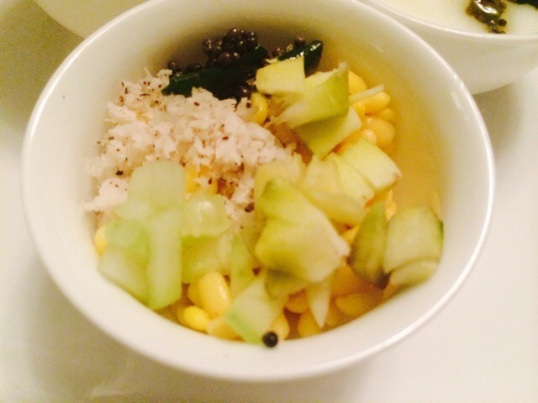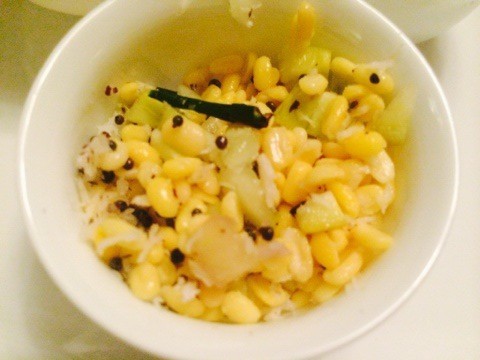Easy Tomato Gothsu (Tomato Stew) – without onion or garlic
It’s the season of Navaratri (festival of Nine Nights) and besides the daily offerings of jaggery laden sweets and protein packed sundals (savory dish made with legumes) to the Goddess, I have to get creative with the daily menu. As with most temple offerings the food cooked during these 9 days is meant to be “saatwik” or strong in the sattwa guna or purity, leading to clarity and equanimity of the mind.
It can be debated as to how the list even originated as it dates back to Ayurveda and food that ancient Yogis consumed. The list we know of includes fresh leafy vegetables, fruits, nuts, seeds and grains, legumes, interestingly diary (raw milk from happy cows:), ghee (clarified butter), raw honey etc. Meat and its by products, some pungent vegetables including onion and garlic were avoided as they were meant to stimulate the tamasik qualities leading to dullness of the mind and body. For the Yogis this was meant to be detrimental to their spiritual aspirations.
As I mentioned before I didn’t really fully understand (and still have some q’s) why some vegetables scientifically considered healthy (like onion and garlic) were excluded from this diet. I do get the meat exclusion to some extent as it follows the doctrine of “you are what you eat” and the relationship between food and the mind. I suppose you could use the same logic to the other foods too?
Oh well. As for me, I tend to consider these 9 days as an excuse to undergo a detox of the body and mind. If you look at that explanation scientifically too Navaratri falls at the juncture of two seasons, when the fall season recedes and and winter season sets in (in the Northern hemisphere). There is a shift in pattern with nature too, the plants shed their leaves, fruits fall and go into a non productive mode, grains are being harvested and so on. The body (and mind) needs to undergo a periodic cleanse to get stronger for sustaining the bleak winter months. Hence the detox during this season which conveniently aligns with the festival too. Traditionally Navaratri is meant to be a time to fast and/or eat sparingly to allow the body to detox.
Isn’t it ironical that detoxes are becoming so popular in today’s times and when you really “peel the onion” (no pun intended;) they are manifestations of what the ancient Sutras and Ayurveda dictated eons ago? Suddenly Yogic practices, Ayurveda are becoming fashionable, a fad and fasting and detox diets once originally done for spiritual reasons are becoming a sought after lifestyle. We have come a full circle and the goal interestingly is the same. To be healthy and strong in body and mind.
So the many offerings to the Goddesses are made as saatwik as possible and for the same spiritual and possibly convenient reasons it trickles down into the daily menu as well.
Today’s prasadam (offering) was Venn Pongal, a traditional South Indian porridge made during festivals but also a filling breakfast or lunch dish. Made with rice and yellow mung beans, it packs enough fibre and protein to balance out the carbs. And garnished with dollops of ghee (clarified butter), another nutritious good fat packed with Vitamins A, D and K.
As an accompaniment for the Venn Pongal I made a Thakkali Gothsu or Spicy Tomato Stew. Super easy to make and quite a tasty accompaniment to the venn pongal, this is a recipe I learned from Amma (my mom). This dish can be made with onions too but for today I made it without them for all the reasons mentioned above:)

Ingredients:
Medium sized tomatoes on the vine – 4, finely chopped
Green chilies – 4-5, slit
Curry leaves – a sprig
Jeera or cumin seeds – 1 tsp
Asafetida – a pinch
Mustard seeds – 1 tsp
Sambar powder – 2 -3 tsp (depending on spice level)
Turmeric powder – 1/2 tsp
Cinatro – 1 small bunch chopped
Oil – 1 tsp
Salt to taste
Method:
1. Heat oil in a pan. When hot add the mustard seeds. After they begin to splutter add the jeera and asafetida.
2. Add the slit green chilies and curry leaves.

3. Add the chopped tomatoes, salt, turmeric powder. Mix well and sauté for 2 minutes.

4. Add the sambar powder, mix, add let cook for about 2-3 minutes.

5. Add about 1/4 cup of warm water and cook again for 5-7 minutes till it all begins to come together in a thin chutney like consistency.

6. Garnish with chopped cilantro and serve hot.
Note: If you’re adding onions, add one medium sliced onion finely chopped, and add it right after the step where you sauté the green chilies and curry leaves. Sauté well till they turn translucent before you add the tomatoes.






































